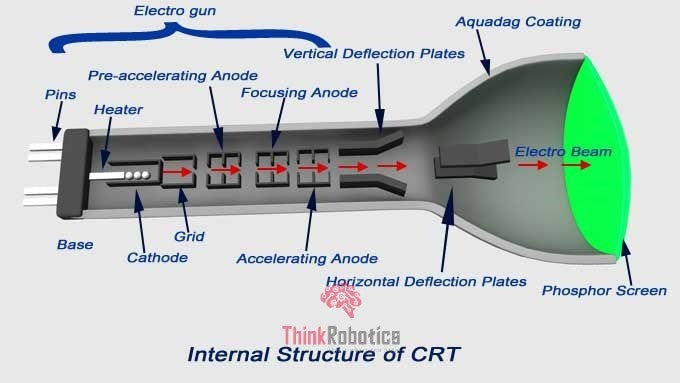All the electronic gadgets we use like calculator, Tablet, smartphones, and even computer has various components on its Printed Circuit Boards. Now, these components like diodes, capacitors, switches, resistors are an integral part of these gadgets, and depending on the values of these, the device's voltage, current, and power vary. Rather, these components' designs are determined by the desired voltage, current, waveforms, and energy.
A very common device that tests all these parameters is CATHODE -RAY OSCILLOSCOPE. Its widely used in college laboratories and industries for testing, understanding, and analysis of various circuits. A cathode-ray oscilloscope is an X-Y plotter representing an input signal versus time or any other signal.
What all does it have?
The Cathode -Ray Oscilloscope has following main components:
- The electron gun
- The deflecting plates
- A fluorescent screen (Phosphor)

Fig 1: Cathode -Ray Oscilloscope
1. The Electron Gun:
It consists of a heater, cathode, a grid, a pre-accelerating anode, a focusing anode, and an accelerating anode. The function of an electron gun is to produce an electron beam. With the help of the heater, the cathode starts emitting electrons. The cathode is coated with barium layers and strontium to facilitate faster emission of electrons since both elements have valency as two and thus easy to give away electrons.

Fig 2: The Electron gun of CRO
After being emitted by the cathode, the electrons pass via the grid or control grid, which controls the emitted electron's intensity from the cathode. It is made of nickel cylinder and is centrally aligned to the CRT axis. While passing through the control grid, the electron is accelerated by a high positive potential, which is applied to the pre-accelerating or accelerating anodes. The focusing anode being positive tries to converge the beam and pass it to the next anode to accelerate further. Followed by which the beam enters into deflecting plates.
2. The Deflecting Plates:
There are two sets of deflecting plates. One is a set of vertical deflection plates called Y plates, which deflects the electron beam in up & down direction. The input signal for examining is given to the vertical deflection plates with an input attenuator and several amplifier stages. This is where the operator adjusts the beam vertically from externally connected knobs.
The other one is a horizontal deflection plate, also called X plates—this set of scales deflects the beam left to right and vice versa. Like the Y plates, X plates are also given input signal for examining, which is done using attenuators and amplifier stages. This is where the operator adjusts the beam horizontally from externally connected knobs. After this, the electron beam falls on the fluorescent screen.
3. The Fluorescent Screen:
Externally the screen of CRO is approx. 10 cm X 10 cm. from inside, this screen is made up of glass, melted, then moulded, and then annealed. This glass is also called faceplate since the face of CRO. This faceplate is covered with phosphor crystal, which converts the electron beam into a light-emitting beam, thus enabling us to see the waveform on the screen.

Fig 3:A look into the inside of the CRO
Working:
The electron gun emits electrons in the form of an electron beam, which is passes via pre-accelerating and accelerating anodes having a positive potential of 1500 V. the focusing anode unites the shaft and has an electrode potential of 500 V . now, this converged beam of electrons passes via each set of deflecting plates. As a result of turning of knobs externally, the beam gets deflected. After which this deflected beam falls on the fluorescent screen. And we get display on the CRO screen externally.
CROs are widely used in laboratories to measure voltage, current, frequency, and phases. The input given to CRO is actually in voltage form, which is later converted to current etc., to measure it.
Sources:
- electrical4u.com/images/internal_structure_CRT_rev.jpg
- images.app.goo.gl/iZeMiEnjbfq6PGtQ6
- images.app.goo.gl/7tcCDCorJZZRN14q6
- circuitglobe.com/cathode-ray-oscilloscope-cro.html
- electrical4u.com/cathode-ray-oscilloscope cro/#:~:text=A%20cathode%20ray%20oscilloscope%20is,variation%20in%20the%20input%20quantity.

